India counts among the rarest of countries blessed with a precious environmental resource, its thick and dense forests ranging from the mountain pastures in Ladakh to the tropical forests in Kerela, from the extensive lush forests in Arunachal Pradesh to the thorn forests in Rajasthan. the wide-spread forests in various states, from the smallest forest to the biggest forest in India are each unique in themselves.
India’s forest cover is diverse and alluring for all. It boosts the economy exponentially, with its high contribution towards India’s GDP, and parallelly thrives the generation with its beauty to explore and experience more about the forests in India. Its surpassing beauty with a wide variety of vegetation, sparse trees, and diverse rich habitat grabs the attention of every nature lover.
Madhya Pradesh bags the largest one from the names of forests in India with 25.11 percent of the geographical area, constituting the Van Vihar National Park in the sate. It is subsequently followed by Arunachal Pradesh, Chattisgarh, and Odisha. The smallest forest in India is of the state Haryana with 6.79 percent of the geographical area.
You can have a sneak-peak from the map below to all the Names of Forests in India which welcome tourists worldwide all round the year to behold the rich heritage.
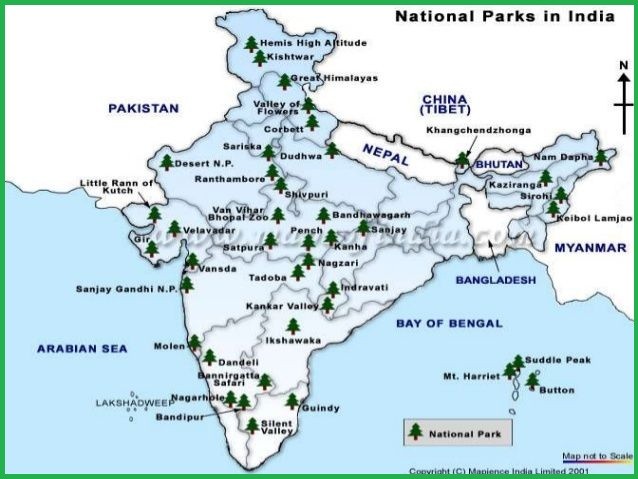
Even if you’re not a fan of the Bear Grylls show, I bet if you visit one forest in India, you will definitely have a plan for another. Saying so, let’s discuss the top 10 names of forests in India which are worth visiting in a lifetime, and count on how!
Table of Contents
Top 10 Forests in India
1. The Sunderbans National Park, West Bengal

The Sunderbans forest in India is a UNESCO World Heritage site, declared as a national park on 4th May 1984. The park stands on the banks of the Ganges Delta in West Bengal.
The Sunderban Mangroves finds a major place in the largest Mangrove System in India. It is home to the world-famous special kind of mangrove tree, know as the Sundari, from which the forest has achieved its name. The magnificent tree has specialized roots emerging above the ground and helps in respiration.
Another main attraction of the Sunderbans is out of the ordinary type of fauna, the White Tiger, also known as the Royal Bengal Tiger. They are famous for their distinctive characteristics of swimming in saline waters and are menacing predators, often seen sun-bathing on river banks of the Sunderban delta.
The Sunderban Forests in India is home to more than 400 tigers, with other stirring fauna such as macaques, leopard cats, fishing cats, Indian grey mongoose, wild boar, flying fox, jungle cat, and chital.
With such exquisite attractions, the bucket list of the Forests in India is certainly not fulfilling without the Sunderbans.
- Location: The park is situated at a distance of 140 kilometers from Netaji Subhash Chandra Bose International Airport, and 29 kilometers from Canning Railway station.
- Climate: Temperature varies from 20 °C to 48 °C, being mostly humid. It experiences heavy rainfall being close to the Bay of Bengal, and the monsoon period is from mid-June to mid-September.
- Prime Attraction: The exceptional mangrove trees, the Royal Bengal Tiger, and other unusual fauna.
- Special Information: Since the park is formed by many flowing rivers, travel to the park is most exciting. One can reach the park through boars offered locally or cruise safaris, provided by the Sunderban Tiger Camp.
2. Gir Forest, Gujrat

Gir National Park and Wildlife Sanctuary, a jewel of the state of Gujrat is also known as Sasan Gir, established in 1965 near the Talala Gir. It is a fragment of the Khathiar-Gir Deciduous Forests.
The forest is a key symbolization of the Asiatic Lions, a true elation for the wildlife lovers. The jeep safari rides mark the prime attraction of the tourists to catch a sight of the Asiatic Lions roaming around hither and thither!
Erstwhile due to excessive hunting by the British Colonials, only a dozen Asiatic Lions were left in India. To restrain the practice and protect the habitat, Nawab of Junagarh established the Gir National Park.
Today the forest has a rich treasury of Fauna apart from the prestigious Asiatic lions, such as the Golden Jackal, Indian leopard, striped Hyena, Ruddy mongoose, honey badger, and rarely seen desert cats. Among the reptiles, mugger crocodiles and Indian Cobra steal the zeal of the sanctuary.
The Gir Forest also homes more than 400 species of Flora, primarily divided into Savannah forests and dry deciduous forests. The majorly spread are the Teak trees, constituting more than half of the area. The panorama of the forest will also include various kinds of conventional species such as Babul(acacia), Jamun, Karanj, Umlo, Amli, and Sirus.
- Location: Located in the hear of Gujrat, the park is present at a distance of 43 kilometers north-east of Somnath and 65 kilometers south-east of Junagarh.
- Climate: It is usually scorching hot in the months of April and May, though it is regarded as the best time for Wildlife Photography.
- Prime Attractions: Asiatic Lions, the very few endangered species of the heritage. Also, the jeep safaris among the desert forests and teak trees are enriching.
- Special Information: Gir National Park remains closed from 16th June to 15th October every year.
3. Sacred Groves (Khasi and Jaintia Hills), Meghalaya
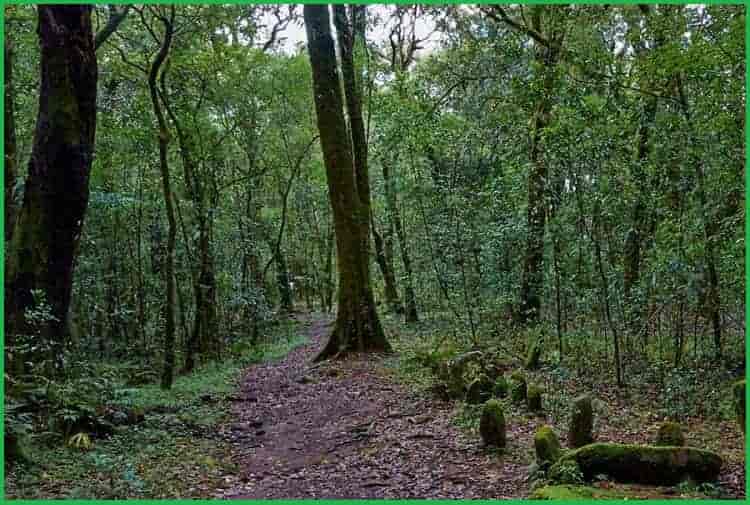
The Sacred Groves in the Khasi Hills and the Jaintia Hills of Meghalaya, among the Forests in India has the most mysterious legendary tale behind its existence. They are the virgin forests protected by the local inhabitants due to their cultural beliefs. An age-old belief goes by, that a goddess ‘U Basa’ dwells among the thick forests. The local people worship the forest and sacrifice animals (goat, buffalo, cow, pig, and fowl) to please the goddess, ‘U Basa’.
It thrills tourists who visit the forest, that in some sacred groves to date, plucking of twigs or the use of wire, steel, slippers, or even Photography is strictly prohibited. It is not hysterical, that even nature’s call is barred.
The Sacred Groves of Meghalaya is the last rampart protecting the rich cultural beliefs and heritage of the indigenous people. With the exception of the mysterious tales of the forest, it harbors a treasury of at least 50 most endangered and rarest Flora, including the medicinal plants and aromatic plants.
The forests are astoundingly beautiful with thick, dense cover and milky waterfalls and fountains everywhere. A nature lover must be surely unhesitant to visit these hilly forests for once.
- Location: The hills are located in the East Khasi Hills of Meghalaya at a distance of 25 kilometers from Shillong, and connect with the Purvanchal Range.
- Climate: As Meghalaya experiences the heaviest rainfall in the country, the sacred forest remains generally wet. Though, the monsoon only enhances its charm.
- Special Information: It is illicit to even take a leaf out of the forest and remember, Photography is banned too in most parts of the Sacred Groves.
4. Namdapha National Park, Arunachal Pradesh

Namdapha (derived its name from the words ‘nam’ means water and ‘dapha’ means origin), is the biggest forest area in the Eastern Himalaya, and third largest National Park in India having an area of 1985 km2 and locates itself in the Changlang district of Arunachal Pradesh. Spotted as highly rich in Biodiversity, the Namdapha National Park and Wildlife Sanctuary have a bountiful assortment of various endangered species and rare plants.
The Park manifests the first specimen of the Namdapha Flying squirrel, a critically endangered species that seizes the attention of the explorers only if they are lucky to find one. It also homes a wide miscellany of mammals and large predators. The most prominent of the mammals noted are the big four- Clouded Leopards, Common Leopards, Snow Leopards, and Tigers. Among the menacing predators are the Asiatic Black Bears, dholes, and wolves, and the little tricky ones include Eurasian otter, small-clawed otter, red panda, red fox, spotted linsang, civets, marbled cat, Asiatic Golden Cat, and many more.
The Namdapha National Park also stands prominent due to its exquisite collection of at least 425 recorded birds, safeguarding 5 species of hornbills, rare wren-babblers, parrotbills, laughing thrushes, and fulvettas. Namdapha is the only Forest in India that showcases the last species of the critically endangered White-bellied Horn and the Snow-throated babbler.
The flower of Sapria Himalaya marks the Flora vision enhancing the charm of the Park.
- Location: Located in Changlang district of Arunachal Pradesh, the nearest accessible railway station to the Park is the Tinsukia Railway station in Assam at about 140 kilometers from the Park.
- Climate: The Park exhibits a varying moderate temperature, though the best time of visit would be October to March.
- Prime Attraction: It’s a rich biodiversity hotspot. Grab a view of the most critically endangered species, before they become extinct.
- Special Information: Elephant safaris, adventurous activities, and the Miao Museum of the Namdapha Park rightly thrill any range of explorers.
5. Jim Corbett National Park, Uttarakhand

Located in the Nainital district of Uttarakhand, Jim Corbett National Park is the first National Park established in India with an area of 1319 kilometers to rescue the endangered species of Bengal tiger which first provoked the Project Tiger initiative. It received its name from a recognized hunter and naturalist, Jim Corbett.
The Park has consistently been one of the favorite destinations of animal lovers due to its unique features. It is the sole Park that allows explorers to stay overnight and catch hold of all the wildlife thrill. It is a unique place where humans are caged in safaris or Elephant backs to explore them freely moving wild – Tigers, rare Otters, some species of deer, and heavenly birds.
If bird watching is your hobby, you ought to visit its bird treasury. Home to around 650 birds including resident and some migratory birds, it shelters the view of over 50 species of raptors.
With the presence of thick dense forests in the Park due to the Sal trees, Winter mornings are extremely rewarding.
- Location: Situated in Uttarakhand, the Park is a fragment of the Sub-Himalayan belt, at a distance of 62 kilometers from Nainital and 260 kilometers from Delhi.
- Climate: Remains usually temperate with mild hot summers, heavy monsoon rainfalls, and foggy beautiful winters.
- Prime Attraction: The Jungle safaris with overnight stays, and its rich diversity of wildlife and bird hotspots.
- Special Information: The Bollywood movie Kaal was shot in the Jim Corbett National park and if you have watched the movie, it sure shot would have occupied its place in your bucket list by now.
6. Bandipur National Park, Karnataka
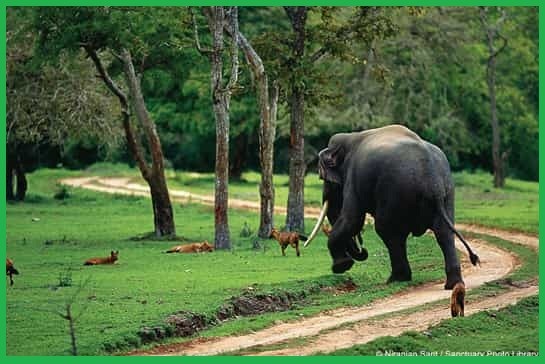
The Bandipur National Park marks its significance with the second-highest tiger population in India, established in 1974 and situated amidst the western ghat mountains.
Erst while, the Maharaja of Mysore created the sanctuary as a private hunting ground and named it Venugopala Wildlife Park, modified today as the Bandipur National Park.
The Park is spread over 874 kilometers, with an enriching view of the Nilgiris and the rivers of Kabini, Moyar, and Nugu passing throughout.
It secures the Flora with a variety of timbre trees and miniature shrubs with a wide range of fruit and flower trees, of which the notable ones are the Kadamb trees, Indian gooseberry, and the golden shower tree.
The Bandipur National Park also serves as a refuge to an abundant endangered Fauna with prominent predators like four-horned antelopes, gaur (a type of bull), sloth bears, panthers, Indian elephants, tigers, jackals, and black-knapped hare.
A captivating view of distinctive birds present in Bandipur often enthralls the visitors with beautiful birds like green pigeons, jungle fowl, red-head vultures, changeable hawk-eagle, bee-eaters, kingfishers, and ospreys. It homes over 200 species of birds, of which the most common is the Peafowl.
- Location: It is located in the state of Karnataka, on the Mysore-Ooty highway at a distance of around 80 kilometers from the Mysore railway station.
- Climate: The place exhibits a tropical climate with dry and hot summers from March until the augment of monsoon in June.
- Prime Attraction: The enthralling hills of the Western Ghats, and situated on the bed of Nilgiris, the park has an abundance of natural scenic beauty.
- Special Information: To control the death rate of wildlife, Traffic movement is barred in the place from 9 pm in the dusk to 6 am in the dawn.
7. Nilgiri Biosphere Reserve, Tamil Nadu

The Nilgiri Biosphere reserve established in 1986, is the first Biosphere Reserve in India. Also now a part of the UNESCO World Heritage Site, it is located amid the enchanting Nilgiri Hills and western ghats of Southern India spread over 1280 kilometers of area.
The reserve is a rich heritage in the diversity of both flora and fauna. It captures around 80 percent of the total flowering plants in the Nilgiris with about 3,300 species. It bags the sole right of shelter to the most endangered plant species such as Jarodina, Adenoon, Baeolepis, Calycanthus, and many more, of which the Poeciloneuron is the most exclusive.
For the wild lovers, the reserve homes over 370 species of birds, 100 species of mammals, 300 species of butterflies, 80 species of reptiles, along with some species of fishes and amphibians.
The curious explorers can hold the sight of two unique species for which the park reserves the right- the lion-tailed macaque and Nilgiri tahr. Explorers can also catch the sight of other wild creatures such as the Bengal Tiger, Indian leopard, Gaur, Malabar giant squirrel, Black panther, and Nilgiri langur.
- Location: It is situated in the western ghats and the Nilgiris at a distance of about 71 kilometers from Coimbatore Railway station.
- Climate: It experiences a tropical climate with adequate rainfall throughout the year, though the best time of visit is from August to December.
- Prime Attraction: The dense greenery amidst the hills and the endangered species whose sole rights are with the Nilgiris biosphere reserve.
- Special Information: Just don’t miss the camera! The scenic is a must-captured beauty.
- Keibul Lamjao National Park, Manipur

For any nature lover, the Keibul Lamjao National Park in Manipur should top the bucket list before any other. It is the world’s only Floating National park spread over an area of 40 kilometers, based on the Loktak lake. A truly bewitching treat to the eyes!
The prime significance of the Keibul Lamjao National Park is the Brow-antlered deer, also known as Sangai, is a critically endangered species. Hence to rescue the species, the park is declared as a Sanctuary in 1966 and National Park in 1977. The Manipuri people also call this species of deer as the Dancing Deer, due to its delicate gait and as it makes its pathway along the wetlands.
Apart from the Sangai, it also homes to an abundant Fauna of which the primitive ones are Rhesus monkey, Assamese and stump-tailed macaques, and slow loris. Among the deers, the other types of species are the hog deer, musk deer, and sambar. It also has a collection of mammals such as the civets, otters, and boars.
For bird lovers, there’s a brownie! The park retreats the view of various types of hornbills such as the wreathed hornbill, brown-backed hornbill, great pied hornbill, and rufous-necked hornbill.
Some of the rarest species in the area which are next to extinct are tigers, leopards, panthers, fox, jackal, wild dog, Himalayan black bear, and the Malayan bear.
The park homes to a distinctive type of Flora, the aquatic flora, and the open swamp areas. The hydrological flora and its conditions make the park one of its kind, and a must-visit.
- Location: It is located in the Bishnupur district of Manipur, at a distance of 30 kilometers from the Tuhilal International Airport, Imphal.
- Climate: Temperature varies highly from 34°C in summers to 1.7 °C in winters.
- Prime Attraction: The captivating view of the floating beds with a rich amalgam of the aquatic ecosystem, and the sight of a wide variety of birds is sure to win hearts.
- Special Information: For a few days during the monsoons, the peripheral bed gets submerged and again floats, a few days later. So, it would be advisable not to visit the Park during monsoon.
Vandalur Reserve Forest, Tamil Nadu

Located in the south-western part of Chennai in the suburb of Vandalur, the Vandalur Reserve Forest in India includes the Arignagar Anna Zoological Park, which is the largest zoological garden in the Indian subcontinent.
It marks a relishing short holiday in the largest zoo with a wide range of animal species, which includes 6 types of deer species- Blackbuck, sambar, barking deer, sangai, nilgai, and hog deer, fascinating monkey species such as the lion-tailed macaque, hanuman langur, Nilgiri langur, baboon, and leaf-capped langur and immeasurably more.
- Location: Vandalur Reserve Forest is primarily located at about 30 kilometers from the core of the Chennai city, in the suburb of Vandalur.
- Climate: The temperate remains generally hot and humid with scorching heat in the summers and almost no winters.
- Prime Attraction: For the animal lovers, the Arignagar Anna Zoo also known as the Madras Zoo is a retreat.
- Special Information: There’s a long trek inside the forest, so better to go prepared!
10. Kanha National Park, Madhya Pradesh

Kanha National Park is the largest National Park of Madhya Pradesh, most popularly known as the Tiger Reserve in India. Located amidst the Maikal chain of Satpuras which form the central Indian Highlands, it was upgraded as a National park in 1955 which forms an area of about 940 kilometers.
The Park is blessed with marvelous landscape and crystal clear streams flowing along the thick-dense jungle providing a jaw-dropping experience to the visitors.
It owns over 1000 species of flowering plants, lowland meadows, and a collection of the prominent Sal trees and mixed forests.
The park also homes a diversity of Fauna ranging from the most populated Barasingha to the swamp dear, fondly known as the “Jewel of Kanha”, menacing tigers and numerous variety of birds, reptiles, and mammals.
The park always experiences the hustle and bustle of the tourists with its well-developed infrastructure, and the most special point “Bammi Dadar” is renowned for the best sunset viewpoint. Also, a Jungle Safari through the Kanha National Park exhibiting the paradise of rich fauna promises a stirring moment for the animal lovers.
- Location: It is located in the Satpuras in Madhya Pradesh, close to Jabalpur airport at a distance of 165 kilometers and 185 kilometers from Raipur airport.
- Climate: It experiences an extreme climate with hot summers up to 43-degree Celcius, monsoon from June to September with average rainfall and cold frosty winters.
- Prime Attraction: Situated at the central highlands, the Kanha National Park bestows a glimpse of rare wild creatures such as the Barasingha, swamp deer, wild dog, and Indian tiger, and offers a spectacular experience of the Jungle safari.
- Special Information: Binoculars and cameras are of immense priority to enjoy Jungle safari the most.
The aforementioned are the most prominent top 10 names of Forests in India, each one of its kind but fulfilling, which often creates an enigma to rate on the priority list, though these are not all. There are still some of the breathtaking forests which are no less than the top 10 such as the Kaziranga National park in Assam and some renowned National parks of the states of Maharastra and Andhra Pradesh.
Maharastra homes for five well-known National parks in the state each competing with the other in terms of the diverse fauna, scenic beauty, and infrastructure. Tadoba Andheri Tiger reserve, being the biggest and oldest National Park of Maharastra, others are namely Gugamal National Park, Navegaon National Park, Sanjay Gandhi National park, and Chandeli National Park.
By the same token, Andhra Pradesh owns for 13 Sanctuaries, 1 National park, and 2 zoological parks in the state. The state has a wide variety of vegetation, but mostly covered with dry deciduous forests with an amalgam of teak and mixed trees.
Pause! Having discussed the top National Parks and reserved forests in India, we cannot afford to miss the variety of forests, to recognize and enhance the viewpoint. For those who are nature lovers but not a fan of Geography, let’s narrowly discuss what are these. India being a diverse country exhibits its diversity in every existent thing, and such distinctive are the forests in India too. The map showcases a brief glimpse of the diverse vegetation of India.
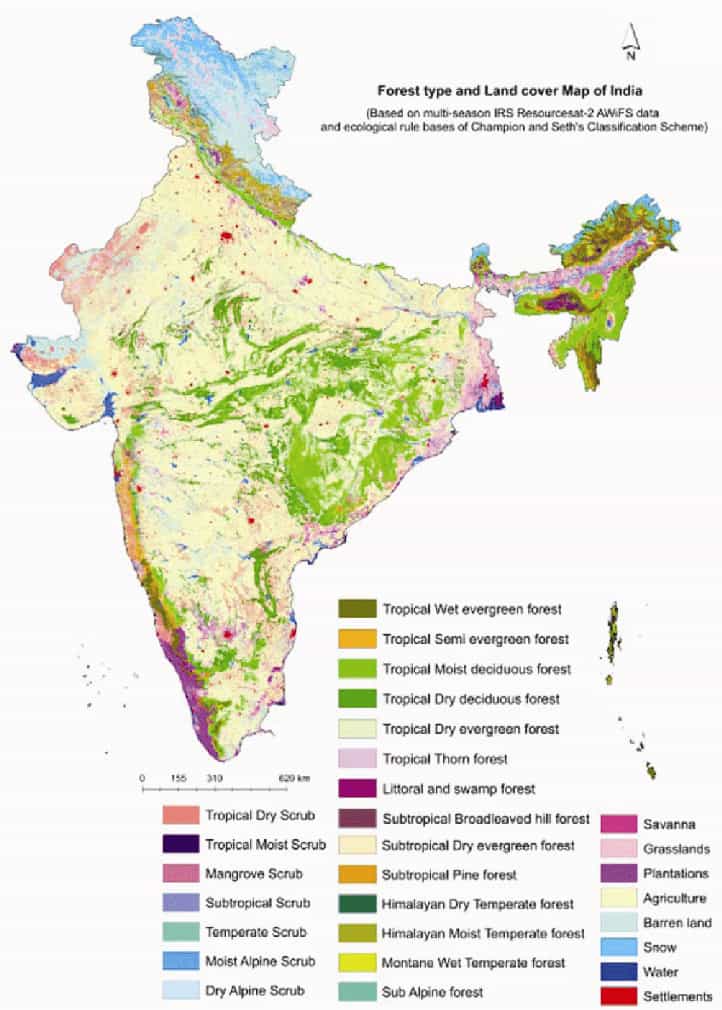
If not all, let’s put forth the major stratification of the forests in India.
1. Montane Temperate Forests

Also known as the Coniferous forests, the Montane Temperate Forests are generally found on the slopes of the Himalayan region or anywhere as the elevation increases. The trees are in the form of long dancing poles with beautiful and bountiful sharp-edged thin leaves, and naturally lower inclination of the branches so that the snow accumulated can slip off easily. These trees can grow at a temperature ranging from 6°C to 12 °C, below which they fail to grow. The ecosystem above this line is known as the Alpine Zone or Alpine Tundra, mostly dominated by low-growing shrubs and grasses.
2. Tropical Moist Forests

Tropical moist forests, also known as the tropical rain forests in India are found in the extreme wet regions receiving an average rainfall of above 250 cm annually in places such as Andaman and Nicobar Islands, Annamalai Hills, Assam, and Bengal. They have sky-scraping trees which are more than 45 meters in height. Also, the woody climbers and epiphytes are in abundance due to theheavy rainfall.
Another subtype of Tropical moist forests is the Tropical moist deciduous forests that occupy the majority Forest Cover in India. They are found in areas of heavy rainfall and shorter periods of dry duration mostly found in the Deccan Plateau of India and Himalayan tracts. These forests produce the most important classifications of Timbres in India.
3. Wet Evergreen Forests

Wet Evergreen forests are found in the areas having heaviest rainfall, where monsoon lasts for substantially longer months. These forests are a real treat to the eyes with clear streams flowing within, and fountains amidst the forest.
The trees are usually lofty overlapping with each other, forming a continuous chain of the canopy. Thus, these are the densest and dark forests, with very little or no light.
Cherrapunji in the East Khasi Hills of Meghalaya receives the heaviest precipitation of rainfall annually in India, thus wholly covered with the wet evergreen forests. Also, these are quite noticeable along the western ghats and most parts of North-Eastern India.
These forests have rich fauna including menacing wild predators and various assortment of insects and birds.
4. Dry Tropical Forests
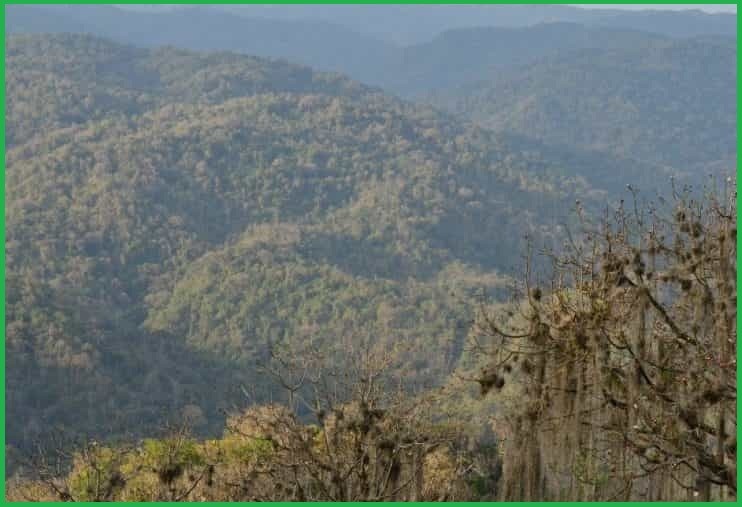
Tropical dry forests can be further classified into dry evergreen forests, thorn forests, and dry deciduous forests.
The tropical dry evergreen forests are present in areas with high annual rainfall, but comparatively longer dry season. They have fragrant flowers and hard-leaved trees, and a variety of deciduous trees.
Generally found in Tamil Nadu and east and west coasts, these trees dense, evergreen and short in height.
Another diversity is the Thorn forests in India, which generally occupy places with very little rainfall ranging from 20-70 cm annually where the dry season is humid and too long. In India, mostly they are found in the major parts of Rajasthan, Gujrat, and Southern Punjab.
This vegetation looks small in structure with thorns and spiny shrubs, mostly devoid of rivers. They are often called the thorny scrubs or the thorny jungles.
5. Deciduous Forests
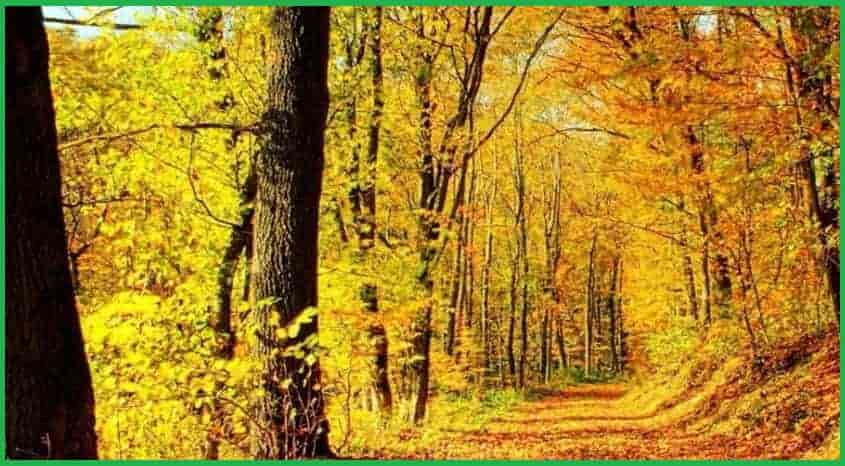
The dry deciduous forests are visible throughout the Northern part of India, except the North-Eastern part of the country.
The most commonly visible trees in these forests are the Sal trees, which are prominent for their long-standing beauty and major utility as astringent in Ayurvedic medicine. Other found trees are the hardwood bamboo trees and a variety of Acacia.
Except for the North, these dry deciduous forests can also be noted in some other parts of the country such as Gujrat, Andhra Pradesh, Madhya Pradesh, Karnataka, and Tamil Nadu.
6. Littoral and Swamp Forests

Littoral and swampy forests can be sub-classified into beach forests, Mangroves, and Freshwater swamps.
- Beach Forests: Found all along the sea beaches and deltas, their soil consists of large amounts of salts, They are found in the area receiving 75 to 500 cm of rainfall annually.
- Mangrove Forests: They are found especially in the river deltas, and grow in muddy areas having mixed type of soil including saline and freshwaters. The roots of the Mangroove trees breathe emerging from the mud banks.
- Freshwater swamps: The freshwater swampy forests grow in the low lying areas where the rain or swollen water has been collected for some time.
7. Alpines

The Sub-Alpine Forests in India are found extending throughout the Himalayas, from Kashmir to Arunachal Pradesh. Here, annual rainfall is less than 65 cm but remained covered under snow for a prolonged time. Most of the year, these forests experience strong winds and below 0°C temperature.
The vegetation in these forests primarily consists of juniper, willow, black currant, red fir, etc. Lichens and epiphytic mosses are found in abundance.
Having discussed the broad classifications of the forests in India, the mentioned still showcases just a glimpse of the rich heritage of India.
There are still tons, yet to be classified and yet to be discovered.
According to the 2019 report, India’s present forest cover accounts for 21.67 percent of the total land of India, which is around 712,249 square kilometers.
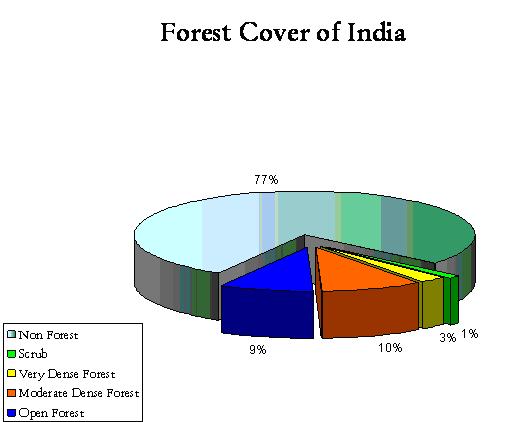
The Forest cover in India has proved to be the best possible boon received since it has diversely served the country through all tough times. The Forests in India contribute to 1.7 percent of the country’s GDP, providing various raw materials ranging from bamboo, wood pulp to saw wood panel products. Taking the example of the paper industries alone, based on the forests, they produce 3 million tonnes annually for over 400 mills. Non-wood forest products such as resins, gums, latex, essential oils, flavors, and aroma chemicals also boost the economy exponentially to aid economic development.
Keeping aside the big picture, Forests are life for the very people. Our survivals depend on the forests from the very purpose of respiration to livelihood for food and shelter. They also provide precious medicines for humans to aid life.
A point to remember, Forests are the second-largest storehouse of Carbon dioxide after the oceans. Forests play a vital role in absorbing harmful greenhouse gases to mitigate climate change. They serve as a buffer in natural disasters like floods and rainfalls, protect us from the erosion of soils and watersheds. Forests help to cleanse us in every way possible.
As a survival factor, only the Forestsemploy more than 40 percent of the population in India. Providing a home to a wide diversity of species in the core of forests, they preserve the heritage of India and protect its culture.
As a token of gratitude, we the debted humans ought to sing the glory of forests and their importance in our lives. Realizing the fact, in 1971, the United Nations of Food and Agriculture Organisation established the World Forestry Day on 21st March, to create awareness about the importance of forests among people. Henceforth every year, the whole world and the country India celebrates World Forest Day on the 21st of March and pay their tribute.
But no such mere day is sufficient to realize the importance of Forests in our lives. This depicts why since the ancient flow of ancestors, they remained very close to Nature and Forests. Forests in India have always remained sacred and close to the people’s hearts, that very often the Forests are treated as deities and Gods, the Sacred Groves of Meghalaya serves as the best example.

The most prominent examples of the sacred trees which are never cut in India are the Banyan tree (Ficus benghalensis), the Peepal tree (Ficus religiosa), and the Khejdi tree (Prosopis cineraria). But except for this, there are an abundant species of trees which are worshiped by the diverse religions and cultures of India, according to their inherent beliefs.
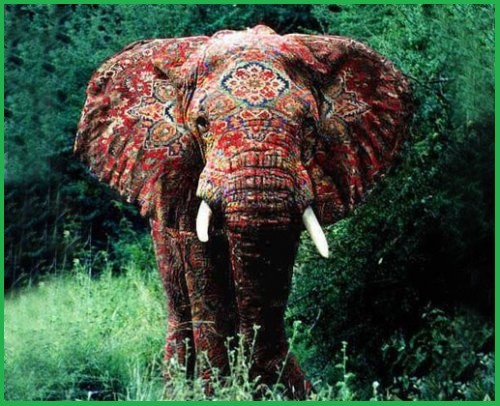
Highlighting fauna, the most popularly worshiped species since the pre-Aryan times are the Tiger, Lion, Cow, Bull, Elephant, owl, and monkey. The Cow is worshiped as the mother of nature, and the famous Pongal festival of India is celebrated offering respect to the cow. Then, the National animal of India, the Tiger is believed to be worshiped since the pre-Aran times and never been hunt. Tigerskin was a piece of seating luxury for the lord “Shiva”. Similarly, Lion is the vehicle of the Indian goddess Durga, and Owl is considered a pet of the goddess Lakshmi. Elephants are widely worshiped across the country, with Mysore organizing the grand festival of Dussera in the worship of the sacred Elephants.
Such inherent practices showcase the rich Indian Culture, bonding closely with nature. Though India is not devoid of the Environmental problems, these facts provide affirmations that preserving the Indigenous culture, we can reverse the loss and head towards sustainable living. The native culture of India promotes harmony and devotion towards Nature, including Flora, Fauna, and natural elements. Hence Forests, home to Nature’s enchant hold an integral part of the Indian Culture.
FAQ For names of forests in India
Q. How much of the total Indian territorial region is under forests?
A. Total 25% and more of the territorial region for the prominent area is occupied by forest and greenery
Q. What are some of the frequent names for trees in India?
A. Teak, Sandal, Shisham, etc. are the common names that would come around.
Q. What is the decided date for the forest day to be celebrated in India?
A. 21st March of every year is the dedicated day for it.
Q. Who is designated to look after the local and national forests?
A. The IFS along with the local guards, residents, and the other authorities are responsible ones.
Q. How many forests have endangered species in India?
A. More than a dozen forests rest the endangered species in their natural state of stay.
Conclusion on names of forests in India
Though there prevails a rich culture of preserving Forests all over the world, it is no new for the people in India.
Erstwhile, the protection of forests and wildlife was a matter of faith reflected in their day-to-day lives, religion, folklore, art, and culture. Our ancient people attribute supernatural powers to natural elements such as plants, animals, mountains, oceans, the wind, sun, and the moon. The Gods and Deities in India are associated with a certain type of animal or plant, and they worship that particular plant or animal instead. Brilliant ways to respect nature have been inherent in such ways in the Indian culture.

